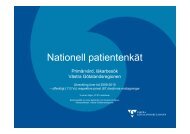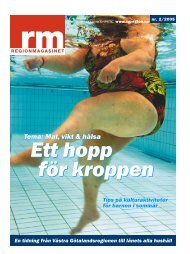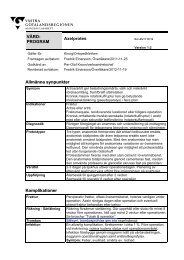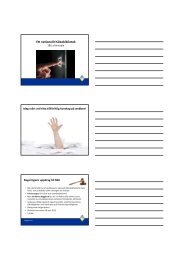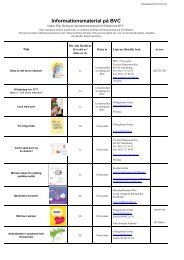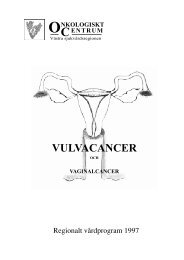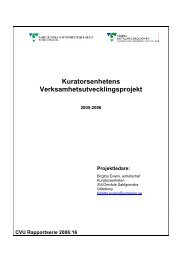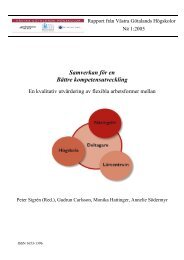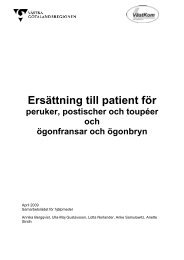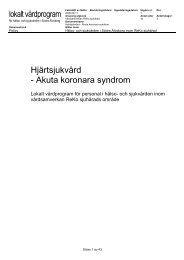FOURTEENTH ANNUAL EUROPEAN PRESSURE ULCER ...
FOURTEENTH ANNUAL EUROPEAN PRESSURE ULCER ...
FOURTEENTH ANNUAL EUROPEAN PRESSURE ULCER ...
Create successful ePaper yourself
Turn your PDF publications into a flip-book with our unique Google optimized e-Paper software.
Wednesday August 31st<br />
Proceedings of the 14th Annual European Pressure Ulcer Meeting<br />
Oporto, Portugal<br />
Pressure Ulcers - Can biomechanical research inform clinical practice?<br />
Dan Bader 1,2*<br />
1* School of Health Sciences, University of Southampton, UK, D.L.Bader@soton.ac.uk<br />
2 Dept. of Biomedical Engineering, Eindhoven University of Technology, the Netherlands<br />
Introduction<br />
Biomechanical research has clearly been successful in<br />
many clinical fields, particularly those associated with<br />
orthopaedics and cardiovascular medicine. Indeed it<br />
can provide an objective differential diagnosis of a<br />
patient presenting at a clinic, and an assessment of<br />
the effectivenes of conservative and surgical<br />
management and rehabilitation strategies A similar<br />
biomechanical approach has also been envisaged in<br />
analysing the complex issues associated with pressure<br />
ulcers. As an example, for years the traditional<br />
mechanism associated with its aetiology was based on<br />
the concept of biomechanical-induced ischemia.<br />
However in the last decade we have been able to<br />
propose alternative mechanisms influenced by<br />
biomechanics, which evoke soft tissue breakdown,<br />
including cell and tissue deformation, ischaemicreperfusion<br />
injury and impaired interstitial and<br />
lymphatic flows [1]. This has necessitated an<br />
hierarchical approach from cell-based studies, to<br />
tissue and animal models [2] to human investigations.<br />
The former provide a means of examining specific<br />
biomechanical effects using controlled cell-based<br />
experiments [3]. However, it is still problematic to<br />
extrapolate these findings to a clinical setting.<br />
The presentation will evaluate what has been learned<br />
from these biomechanical approaches to inform<br />
clinical practice. In many cases, they have highlighted<br />
the need for caution, for example, in the use of<br />
pressure maps alone to evaluate the loaded interface,<br />
the establishment of a universal safe pressure levels<br />
and in the consideration of local tissue biomechanics.<br />
Nonetheless, there is considerable grounds for<br />
optimism that from a biomechanical point of view, we<br />
are now in a position to provide objective guidelines for<br />
the clinician who is directly involved in the prevention<br />
and treatment of pressure ulcers. Indeed the<br />
presentation will emphasize the importance of new<br />
biotechnologies, which could be adapted for use in<br />
identifying those patients at particular risk of<br />
developing pressure ulcers and providing them with<br />
personalized support systems. This can only be<br />
achieved by a multidisciplinary team involving<br />
scientists, clinicians and industry.<br />
Acknowledgements<br />
I gratefully appreciate the help of many collaborators<br />
that have shared my passion for pressure ulcer<br />
research over many years. Special thanks must go to<br />
41<br />
my long time colleague in Eindhoven, Dr Cees<br />
Oomens, the current president of EPUAP.<br />
References<br />
[1] Bouten et al. Archives Physical Medicine<br />
Rehabilitation 84: 616-619, 2003<br />
[2] Loerakker et al. Annals Biomedical Engineering.<br />
38(8):2577-87, 2010<br />
[3] Gawlitta et al. Annals Biomedical Engineering.<br />
35(2): 273-84, 2007<br />
Copyright © 2011 by EPUAP



